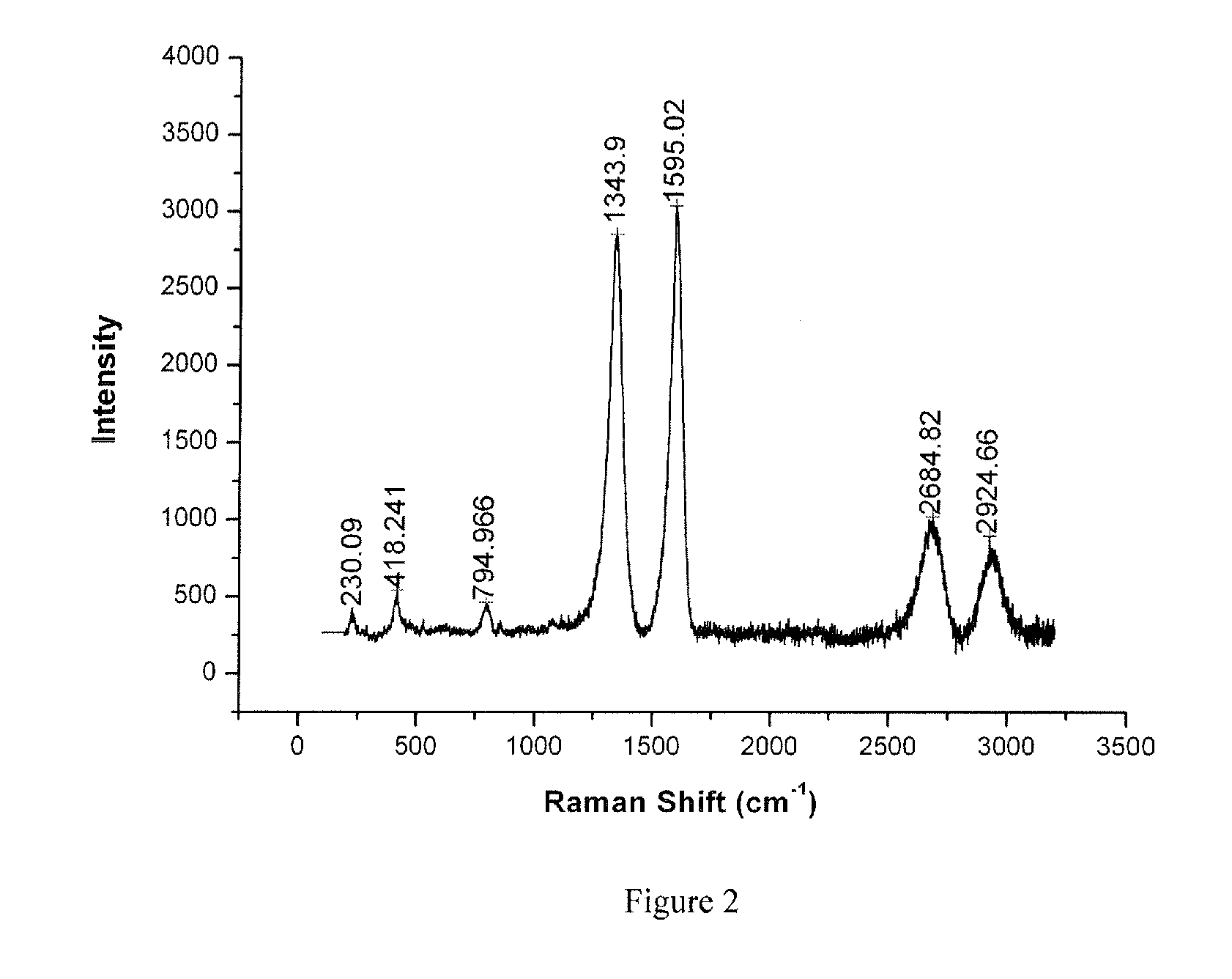Process for developing a composite coating of diamond like carbon and graphite on silicon carbide grain by indirect arc plasma heating dissociation
a technology of diamond like carbon and graphite, which is applied in the direction of carbide, crystal growth process, condensed vapor, etc., can solve the problems of difficult control of selected temperature, difficult placement of charge (material under processing) in the limited space available, and the difficulty of heating above 1800° c., so as to improve the possibility of more dlc and graphite formation
- Summary
- Abstract
- Description
- Claims
- Application Information
AI Technical Summary
Benefits of technology
Problems solved by technology
Method used
Image
Examples
example 1
[0069]SiC powder in mixed phase (α+β) prepared from rice husk by carbothermic reduction in arc plasma (B. B. Nayak et al., J. Am. Ceram. Soc. Vol. 93, page 3080-3083, 2010) was used for high temperature dissociation by indirect arc plasma heating to produce composite coating of DLC and graphite. 10% of SiC grains in the powder were −1 and graphite peaks at 1595.02 cm−1 (prominent) & 2684.82 cm−1 (weak) due to G bands, 2924.66 cm−1 (weak) due to sp2C cluster on the surface along with weak SiC peaks occurring at 794.966, 418.241 and 230.09 cm−1 (due to underneath SiC grain on which composite layer has grown). Micro hardness measured on SiC grain surface coated with the composite (DLC+ graphite) shows upper range value between 2120 to 2540 VHN0.1.
example 2
[0070]Aldrich make SiC powder (No. 409-21-2) in mixed phase (α+β) with 20-50 μm grain size was used for high temperature dissociation by indirect arc plasma heating to produce the DLC+ graphite composite. Heat treatment procedure adopted was similar to example 1 described above. Experimental conditions adopted here are as follows:
Wt. of SiC powder taken: 20 g
Rate of Ar (plasma forming gas) flow in arc: 7 lit per min
Gas passed in graphite crucible: Ar+H2
Rate of flow of gas in graphite crucible: Ar at the rate of 3 lit per min,[0071]H2 at the rate of 1 lit per min
Arc length: 2 cm, Arc conditions: voltage 55-65 V dc, current 500-550 A
Time duration of SiC heat treatment in crucible: 15 min
Temperature of heat treatment: 2980° C.
[0072]Micro Raman spectra characterization (FIG. 3) of the composite coating on SiC grains show strong peaks at 1343.98 cm−1 due to DLC, at 1580.18 and 2699.13 cm−1 due to graphite (G band), weak peak at 2915.93 cm−1 due to sp2C cluster besides other weak peaks a...
example 3
[0073]CUMI (Carborandum Universal) make SiC powder of 800 grit size (grain size 6.50 μm) underwent high temperature dissociation to grow DLC+ graphite composite on SiC grains in the same way as described in example 1. The experimental conditions adopted are as follows:
Wt. of SiC powder taken: 20 g
Rate of Ar (plasma forming gas) flow in arc: 6 lit per min
Gas passed in graphite crucible: Ar
Rate of Ar flow in graphite crucible: 2 lit per min,
Arc length: 2 cm, Arc conditions: voltage 60-65 V dc, current 500-550 A
Time duration of SiC heat treatment in crucible: 15 min
Temperature of heat treatment: 3030° C.
[0074]Micro Raman spectra characterization (FIG. 4) of the composite coating on SiC grains show strong peaks at 1339.52 cm−1 due to DLC, at 1592.26 due to graphite, small peak at 2681.12 cm−1 due to graphite, weak peak at 2922.33 cm−1 due to sp2C cluster besides two other medium intensity peaks at 967.175 and 787.014 cm−1 due to SiC. Micro hardness measured on SiC grain surface coated w...
PUM
| Property | Measurement | Unit |
|---|---|---|
| temperature | aaaaa | aaaaa |
| current | aaaaa | aaaaa |
| voltage | aaaaa | aaaaa |
Abstract
Description
Claims
Application Information
 Login to View More
Login to View More - R&D
- Intellectual Property
- Life Sciences
- Materials
- Tech Scout
- Unparalleled Data Quality
- Higher Quality Content
- 60% Fewer Hallucinations
Browse by: Latest US Patents, China's latest patents, Technical Efficacy Thesaurus, Application Domain, Technology Topic, Popular Technical Reports.
© 2025 PatSnap. All rights reserved.Legal|Privacy policy|Modern Slavery Act Transparency Statement|Sitemap|About US| Contact US: help@patsnap.com



